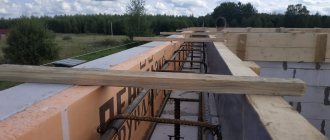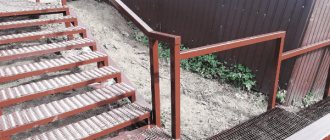Read in the article:
- Excavation works, dewatering
- Formwork, reinforcement and concreting
- Curing
- Waterproofing and insulation
- Common Mistakes
The cost of the foundation is approximately 20–25% of the price of the house box, and therefore the desire of developers to reduce some of the costs is quite understandable. But smart savings, for example, through the use of efficient foundation designs, are one thing. And quite another thing - saving on the quality of materials and professionalism of performers
Such “frugality” leads to numerous errors, and correcting them will be difficult and expensive (up to 50–70% of the total construction costs), and sometimes simply impossible. What mistakes are made when building foundations?
Basement/basement under a used house - going deep correctly
Ideally, the feasibility of constructing a ground floor or basement is determined at the design stage, and construction is carried out in compliance with a certain technology. In reality, the need for additional premises may arise much later, when a house is purchased that requires major reconstruction, or the opportunity arises to add the desired amenities to your own. Not everyone has the opportunity to build a separate technical room or allocate a room for it; sometimes it is more realistic to go deeper and build a basement. Among the users of the FORUMHOUSE portal there are craftsmen who solve such problems with positive results. In this article we will tell you how to build a basement for a house.
How to dig a basement in a finished house
It’s worth mentioning right away that the possibility of building a basement under a standing house depends on the type of foundation. Tape, pile or pile-grillage allow similar manipulations; nothing will work with slab. And the point is not even in the titanic efforts that need to be made to dismantle even part of the slab, but in the fact that a violation of integrity is a loss of load-bearing capacity. The type of box also matters - you can build a basement under a stone structure, but you won’t be able to put a basement under the walls, whereas a log house or a timber house can actually be “hung out” and raised using the basement. Another important parameter is the type of soil and groundwater level. If the GWL is high, deepening will be extremely difficult, if not impossible. Hard-plastic clay means that you will have to dig long and tediously, use a crowbar or a hammer drill, since you will have to literally “gnaw out” each piece.
The main difference between the construction of a basement in a finished residential building and the first stage of construction is manual labor: you will have to dig, select soil, and pour the mortar on your own, without the use of special equipment. Therefore, it is difficult, long, difficult, but it is possible, as proven by our craftsmen.
How to build a basement in a built house: personal experience
Initial data: strip foundation 7x10 meters, buried 70 cm in clay (or 120 cm from the ground), width - 40 cm, reinforcement with a diameter of 16 mm, two rows of two lines. The weight of the house is about 120 tons. The soil is hard-plastic clay (after removing 40-50 cm of the fertile layer, they knocked out the foundation with a crowbar, it was impossible to dig with a shovel), the groundwater level is below seven meters. I will deepen the basement below the foundation, I agree that it is correct and easier to dig a pit right away, but we work with what we have.
In order not to make mistakes, alex_gagra created a topic on the forum in which he asked more experienced comrades to explain how to dig a basement, to clarify the technology, and they responded to his request. The process boils down to manual digging of a pit of the required depth and subsequent concreting of the walls and floor. Concreting is necessary to maintain the bearing capacity of the foundation and compensate for lateral pressure. The most important question is at what distance from the base of the foundation the pit should be dug and the wall should be poured. The answer was given by one of the discussion participants.
Digging from the base of an existing foundation is permitted within a 30-degree zone from the horizontal of the base. This is the simplest method; the shape of the excavated soil will be obtained, corresponding to an inverted truncated pyramid from the base of the foundation.
In another thread the answer to the same question is slightly different.
From the vertical of the tape, lay down an angle of 45 degrees. This is the supporting part of the soil on which the tape stands; it cannot be touched.
In principle, both options are correct, only the first is justified for hard-plastic clays with low groundwater level, but you should play it safe and make the angle larger if the soils are looser.
Taking into account the advice of experienced people, alex_gagra drew a plan diagram of the basement before starting work.
And he brought it to life - they stepped back a meter from the foundation, dug a trench along the perimeter to the level of the base, the height from the ground level to the floor slabs was 2.2 meters. We assembled formwork 20 cm wide, made of OSB (one wall), tied the reinforcement frame, poured concrete using a mixer (we managed to make a receiver instead of dragging it with buckets). At this point the first stage ended, the concrete was left to mature. Two weeks later, the construction entered the second phase - they dug up the remaining soil and poured tape under the partition. There are no cracks or dampness under the formwork. In the future, it was decided to lay out the floor with tiles.
Neglecting the soil research stage
Geological surveys are regulated by a separate set of rules and must be carried out on the site. Moreover, experts advise ordering not express geology, but a complete analysis of the soil on the site. This study will determine all the features of the soil structure. A common mistake is to ask your neighbor about the results of geological surveys and decide that the same is true on your property. But saving on this procedure can subsequently lead to much more serious losses. For example, there may be a water or peat lens under the house, and absolutely nothing will hint at its presence unless a study is carried out directly in the place where the house is planned to be built.
The results of “geology” will clearly show what type of foundation is suitable for your house, how deep the drainage should be, how high the groundwater is (and therefore how to work with basement waterproofing) - without this research, you greatly risk the entire stability of your future home.
Deepening the basement under the house below the base of the foundation
A basement can increase the usable area of the house without changing the external dimensions. But what if the decision on its construction is made at the moment when the house has already been built. There is a way out - deepening the basement below the base of the foundation.
It is immediately worth noting that the arrangement of a basement costs owners twice as much as the construction of above-ground floors; expenses will be required for high-quality waterproofing from groundwater. Exceptions include basement floors located on dry soils. However, for the owners of a two-story house built on a small plot of land, having a basement is simply necessary.
Lack of waterproofing
Waterproofing is one of the most important points in arranging not only a strip foundation, but any foundation for a house. If this is not done, there is a risk of destruction of the foundation structures itself. In addition, the basement or ground floor (if there is one) must be protected from moisture penetration.
The strip monolithic foundation is waterproofed along the entire upper surface - where it comes into contact with the soil. There are several popular methods of waterproofing. A separate article of the project will be devoted to this; here we will only briefly list them.
- Spraying (waterproofing composition is applied from spray equipment to the surface of the foundation tape). This composition fills the pores of the material well, but this method is more expensive than most others.
- Coating with bitumen mastic - this method can be called classic. The entire foundation, including its underground part, is coated with mastic.
- Ruberoid or other rolled materials. This method complements the previous one (roll material is glued to bitumen mastic). In addition, the upper horizontal plane of the foundation can also be waterproofed with a couple of layers of roofing material.
- Primer for deep penetration concrete.
Photo: svoimirukami.lesstroy.net
Basement construction technology
The optimal height of the basement is 2.0–2.2 m. This height is suitable for arranging both utility rooms and placing additional heating or water treatment equipment. The basement floors are constructed in height equal to the living quarters, namely 2.7–3 m.
The ceiling will serve as the ceiling for the basement, and the strip foundation will serve as the walls. The use of reinforced concrete and penetrating waterproofing provides the result desired by the owners. The width of the basement walls during deepening is built taking into account the horizontal soil pressure (bulging). Depending on the material used, which will subsequently line the pit, the thickness of the walls is determined according to the table.
Table of materials used
Table of materials used
Cold floor on the first floor
During the construction of the foundation, errors may be made in the insulation of the basement, which leads to cooling of the ceiling. There are several solutions to the problem:
- Insulate the floor as much as possible;
- You can work on the basement insulation from the inside - it is not necessary to dig out the walls from the outside. To do this, polystyrene or mineral wool slabs are attached to the basement ceiling.
The problem is especially felt in houses with pile foundations, where walls may be completely absent. In this case, the best option is to equip the walls with insulation.
Arrangement of a cellar indoors
Determine the location of the basement in the house: under the entire area or in a specific room. For ease of installation of ventilation (we take the pipe outside, along the walls of the building), it is better to orientate ourselves closer to the outer walls or corners of the house. When marking, take into account the thickness of the walls in order to obtain the “clean” dimensions of the cellar. As a rule, its dimensions are 2x3x2 (width, length, depth). A prerequisite when applying markings: equality of the diagonals of the rectangle.
Dismantling the screed
The time and effort required to dismantle the concrete screed will depend on the thickness of the layer and the presence of reinforcement in it. Everything is simple if the concrete floor is laid in a thin layer. You will need:
- angle grinder (grinder);
- diamond disc for concrete;
- hammer drill
The edges of the designated rectangle are cut through with a grinder, then the internal area is dismantled with a hammer drill. If the screed lies in a thick reinforced layer, then when working with the chipper, when you reach the metal rods, clean them of concrete dust and cut off the angle grinder, replacing the circle with a metal disc.
The hole is dug to the depth of the basement, plus 0.3 m for the thickness of the bedding and ceiling. The walls should be as smooth as possible in order to reduce the consumption of concrete during the construction of walls. We level the bottom of the pit and fill it with slag 0.1 m thick, spill it and compact it. A reinforced concrete slab is poured onto the prepared bottom or asbestos-cement slabs are laid. After construction, the walls and base of the basement must be covered with two-layer waterproofing, the upper edges of which will be securely fixed at the junction with the base of the house foundation using a gas burner.
There are two types of formwork in the basement:
- removable;
- non-removable.
Fixed basement formwork
To install removable formwork, we use wooden boards or panels of the required size. A rectangular box is knocked together from them, smaller than the size of the cellar by the thickness of the walls. We install the formwork at the bottom of the pit. We stuff square bars into the corners for structural rigidity. If the basement floor is not yet concreted, then we drive in iron rods on the outer sides of the formwork. They will serve as spacers to fix the structure. Also, the role of spacers when constructing formwork can be performed by metal horizontal rods that protrude beyond the edges of the formwork and are securely fastened with tension screws or ordinary nuts of a suitable diameter. After removing the formwork, the ends are cut off with a grinder, and the remaining part of the concrete will serve as reinforcement of the structure. When using permanent formwork, spacers will serve as jumpers installed between the walls of the formwork. When pouring concrete, do not forget to tap the formwork with a hammer so that voids do not form and the wall turns out monolithic.
Installation of formwork.
The foundation of a residential building must rise above the ground surface by at least 15 cm. In flooded areas, the height of the above-ground part of the foundation can reach 50-70 cm. The formwork is assembled taking into account the required height, using available materials. Installation of foundation formwork
Installation of foundation formwork
When installing the formwork you will need:
- edged boards with a thickness of 2 cm or plywood sheets;
- polyethylene film;
- roulette;
- screws or nails;
- hammer and screwdriver;
- bars for spacers.
Strip foundation formwork for a house.
The boards are fastened into rectangular panels, secured with transverse bars on the outside. Self-tapping screws are screwed in from the inside to make dismantling the formwork more convenient. For the same reason, it is recommended to use screws rather than nails. When assembling, you should consider the location of the sewer holes and make cuts of the appropriate diameter in the boards. Finally, the boards are covered with a film that will not allow the wood to absorb water from the solution.
The formwork is installed in parts on both sides of the trenches, and then reinforced with transverse bars every half meter. The boards are placed strictly vertically, maintaining the same distance between opposite sides along the entire length of the perimeter. From the outside, the formwork is supported by spacers made of timber. There should be no gaps between the bottom edge of the shields and the top edge of the trenches, otherwise the solution will leak out.
Pros and cons
It is generally accepted that installing a basement below the base of the foundation is very expensive, but the arguments are quite unfounded. The utility room of a two-story house can increase the usable area and actually get three full floors.
Again, in this case, you will not have to occupy the first floor with technical equipment, which can be moved to the basement. An underground space provides a lot of undeniable advantages, which is why projects of two-story houses with a basement have become widespread.
Groundwater
You have decided that your house will have a basement, no matter at what stage of construction. Be sure to determine the groundwater level, otherwise there is a high risk of “drowning” all investments. In the middle of the hottest month (if possible), dig a hole 1.5–2.0 m deep and see if there is water at the bottom. Observe for at least 24 hours. If this is not possible, interview neighbors who have already built basements. In the video you will see how to correctly measure the groundwater level and organize drainage.
The decision to build a basement below the base of the foundation is up to you; refusing it means cutting costs in half, and laying it out and thinking about it in advance means saving on additional technical premises on the first floor of a two-story house.
Correctness of calculations
Before starting excavation work, it is necessary to properly assess the soil.
The type of soil determines to what depth the trench should be deepened, what shape is best to dig the foundation for the house and how it should be secured. In addition, you should firmly know the groundwater level and the depth of soil freezing in the area. Digging of trenches is intended for the implementation of work on the installation of deep and shallow strip foundations:
Foundation type/Depth/Soil type/House weight
| deep-seated | below the soil freezing level (up to 2 m) | any | no restrictions |
| shallow | 0.5-0.7 m | sandy | light buildings |
When constructing a shallow foundation, a sand cushion about 25 cm deep is usually poured under the waterproofing tape. On loose soils, the walls must be immediately strengthened to avoid crumbling.
Dredging the foundation
Why and why to deepen the foundation?
Foundation drainage device.
Most often this is done to obtain a real possibility of exploiting additional space underground, or when carrying out various reconstruction work in construction sites. How to deepen the foundation and what methods exist for this?
General information on deepening the foundation
Foundation depth diagram.
Here is a brief description of actions that can help you understand how to deepen the foundation.
- When deepening the base of the foundation, the walls are strengthened with struts.
- After this, the foundation is excavated and the soil is removed.
- In the recessed space, the walls are strengthened and the basis is prepared for the future new foundation.
- The old foundation, or rather its base, is cleared of pieces of crushed stone and soil, and if it has rather weak strength, then it is better to dismantle it.
- The resulting seam at the junction of the new and old foundation is sealed using hard cement mortar with the addition of crushed stone.
- The foundation is laid gradually, moving from one small area to another. But if such a possibility exists, then work on deepening the old foundation can be carried out in two or more areas at the same time, the main thing is to comply with the condition that requires a distance from one to another of at least 3 meters.
But this is a general characteristic of work aimed at deepening the structure; in practice, there are various methods, such as: using brickwork, monolithic concrete or reinforced concrete.
We will consider these methods and some nuances below.
We deepen the old foundation using the brickwork (rubble) method
Scheme of the construction of a rubble concrete foundation.
The above method is quite complicated to implement, and it is most advisable to use it under existing loads that are insignificant. If all the conditions are met, then first of all they work on unloading the foundation and, if weak sections of the wall are detected, they install a rand beam.
- Next, they proceed to work on small grips (from 1.5 to 2 m), located separately and in a predetermined order, and excavate wells to the depth specified in the project. At the same time, do not forget to temporarily strengthen the walls and dismantle the weak section of the foundation (lower). This is not always done, but only when necessary.
- Next, the soil is removed and temporary fortifications are placed under the foundation. After completing the preparatory work, you can begin to build a new foundation. This must be done while performing mandatory ligation of sutures. All fastenings are removed from bottom to top. The resulting joint between two sections of the foundations must be caulked using a semi-dry mortar of cement and sand. The proportions of this composition correspond to the value 1:3.
Installation of the reinforcing frame.
How to correctly calculate the foundation for a house.
Installation of reinforcing frame
The presence of a reinforcing frame in the thickness of the foundation allows you to strengthen the foundation and extend its service life several times. For the manufacture of the frame, steel reinforcement with a cross section of 10-16 mm is usually used. It is very important to tie the rods correctly in order to distribute the load evenly over the entire area.
Reinforcement of a strip foundation for a house.
To work you will additionally need:
- knitting wire;
- building level;
- Bulgarian;
- plastic pipe scraps;
- roulette.
The reinforcement is cut with a grinder to the length and width of the trenches, after which a lattice with cells from 30 cm is knitted from it. To do this, 4-5 longitudinal rods are fastened with transverse sections every 30 cm.
Correct knitting of foundation reinforcement for a house.
It is strictly not recommended to use welding for connections, since it weakens the fastening points and promotes corrosion of the rods. The frame must be voluminous, so horizontal gratings are placed on 3-4 levels, tied with vertical rods.
Foundation frame for a house.
Additional fastenings should be made at each corner of the foundation and at the intersections of load-bearing internal walls. You can lower the frame into the trenches in parts, and already connect them together inside. To avoid corrosion as much as possible, the reinforcement cannot be laid directly on the sand: take an old plastic pipe, cut it into rings 4-5 cm wide and place it under the grate in the corners and every 50-60 cm along the trenches. Approximately 5 cm should be left between the side walls and the edges of the frame, the same applies to the upper edge of the reinforcement.
Reinforcing the foundation for a house.
Installation of reinforcing frame
When the grid is fixed inside the formwork, the level of concrete pouring is indicated on the inside of the panels. You can do this using fishing line: small nails are stuffed at the ends of the formwork and a fishing line stretched strictly horizontally is secured to them. It should be located 5 cm above the edges of the reinforcement grid and run along the entire perimeter at the same horizontal level.
Deepening the foundation using monolithic concrete
Diagram of a monolithic reinforced concrete floor.
If we compare this method with the one described above, it is considered more effective. The order of work resembles the previous version in its algorithm.
- First, a front of work is carried out aimed at unloading the foundation, after which it is necessary to dig holes. The depth is at least 0.7 and up to 1 m lower than the location of the foundation base. The walls of the pits are strengthened using shields. At the front wall, it is necessary to install a fairly strong frame made of timber or wood, preferably round.
- Make sure that the top of the frame is approximately 40mm lower than the base of the foundation.
- Next, in the space separating the sole and the top of the frame, boards need to be driven directly into the soil. In other words, arrange a fence; it will perform a protective function for the process of digging a well. The depth of the well must be reflected in the design.
- Next, the well is filled with concrete mixture, which must be compacted. Do not forget that you need to leave a gap of 300 mm between the surface layer of concrete and that part of the foundation, which is called the base.
When the concrete reaches the level of required strength, using a jack, you need to compress the base of the constructed foundation. These actions utilize the mass of the existing house. Now you can concrete the left gap using concrete mortar. Concrete must be laid approximately 100 mm above the base of the existing foundation. This way you can achieve the desired completeness of contact.
How to prevent cracks
The formation of cracks can be prevented by following the following standards when constructing the foundation:
- Use quality concrete
- Follow the filling technology
- Correctly calculate the future load
- Follow reinforcement technology based on load calculations
- Maintain the required time when concrete hardens
- Install a drainage system made in accordance with the standards 0.3-0.5m below the foundation
- Basement and concrete foundation cracks that are the result of too much moisture and water can be prevented using various waterproofing methods.
Important: In order to do everything correctly, following all the rules and regulations, you need to choose a qualified construction company that specializes in certain works, and does not do everything. To install foundations, choose a company whose specialty is foundations, and for waterproofing and drainage, choose a company whose specialization is waterproofing and drainage.
You can find how to find a professional company or contractor and not make mistakes in the following article - Contractors, companies and firms for waterproofing and drainage.
Some features
At the moment when you are building a foundation, special attention, in addition to the correct depth, should be paid to the accurate execution of alignment work. In addition, it is mandatory to comply with the technological rules of construction and carry out the correct calculation of the entire fundamental structure, while taking into account all types of loads from the construction site and the qualitative features of the soil, which allow it to accept the existing level of load without being subject to deformation processes.
Calculations and various methods by which foundations are constructed will help you with this. When performing them, the different characteristics of the building materials used and the methods of their installation are taken into account. It is this option that will result in a perfectly suitable technical solution that will make your foundation the most reliable, with a high degree of strength and quite economical.
And, of course, to achieve this goal, it is most advisable to seek help from professionals who have the necessary knowledge in all areas, from engineering to geological. They will also be able to easily apply all the standards in practice, calculate the necessary coefficients and other important parameters.
Safe recess of the basement below the base of the foundation
It’s great when, when building a house, the smallest details are thought out in advance. But sometimes new ideas and requirements for their implementation appear during operation. Most often, this problem is faced by a person who has bought a house or garage. It happens that not all needs are taken into account initially, especially if this is the first construction. For example, demolishing or rebuilding a wall, laying or cutting an opening, or adding a veranda is not too difficult if you have the skills. But what if the basement ceiling is not high enough?
Before starting work on deepening the basement, it is necessary to carry out the necessary calculations and decide on the method of strengthening the foundation.
Of course, raising the ceiling, and with it the whole house, in this case is impossible or too expensive. The only possible way is to move down, that is, to deepen the basement. If during the initial construction achieving the required depth of the basement is only a matter of technology, then when deepening it, you will have to face the fact that the base of the old foundation will be higher than the new depth of the basement floor. The most important thing when carrying out such work is to carry it out without damaging the structure of the building and the safety of its operation, because the slightest shift in the foundation can cause serious damage to the walls and even their collapse.
So, you should always start deepening basements with a careful study of the foundation. It is necessary to clearly understand its design, depth, load distribution of the building walls, as well as the groundwater level.
You definitely need to think about how to strengthen the foundation and carry out the necessary calculations.
Preparatory work
Groundwater
At whatever stage of building a house the decision to build a basement is made, it is important to find out the groundwater level so that there is no flooding of the underground premises.
In summer, when the water level is low, a hole is made 2 meters deep into which the slats are lowered. A day later, it is removed and the bottom is checked for the presence of water. If you have neighbors nearby, you can ask them for this information.
Recessing basements below the base of the house is the business of every owner, and refusing to build such a room saves the estimate by at least twice. And such an underground room, thought out at the design stage of a house, can make the house more spacious and expand the possibilities for arranging the first floors.
Several options for strengthening the foundation
Scheme of strengthening the base and arrangement of the basement floor when it is deepened by 15-30 cm (at a high groundwater level).
Transfer the foundation to the piles. To do this, at the corners of the existing foundation and every 1.5-2 m, wells with a depth of at least 2 m should be drilled and filled with concrete. After the concrete gains strength, you can deepen the basement. In this case, the base of the foundation remains in its place, the load is distributed on the piles, and the ground under the foundation is covered with brickwork or a concrete wall.
Consistently deepen the existing foundation. Every 2 m, dig up the ground underneath in small sections 20-30 cm wide and fill it with concrete. Gradually allowing the concrete to gain strength, deepen the entire foundation in the same small parts.
Build a supporting wall along each wall. Gradually dig trenches along the walls and pour concrete walls below the base of the foundation, always overlapping with the existing walls. In this case, the depth of the trenches should be at least 30 cm below the planned floor level.
Scheme of strengthening the base and arrangement of the basement floor when it is deepened by more than 50 cm (at a high groundwater level).
Finally, the simplest way. It is recommended to use it for garages and small houses. Deepen the basement in the middle and stop work, not reaching 0.5 m from the walls and foundation. The result will be a kind of step around the perimeter of the basement. It needs to be strengthened and filled with concrete. We'll have to think about its future use.
Whichever method you choose, it is extremely important to proceed with caution, taking your time and not allowing the foundation to settle. The following simple rules should be followed:
- Do not strive for large-scale work; it is better to deepen the basements gradually.
- Before pouring concrete piles or walls, they must be reinforced.
- Remember to waterproof your new foundation.
- It is necessary to arrange a sand cushion under the concrete.
After strengthening the foundation, further work is a matter of technology. All that remains is to select the soil to the required depth and fill the basement floor, taking care of its waterproofing.
Improper trench preparation
Perhaps this control point is the easiest to ensure, even without understanding anything about construction. First, the trench needs to be dug to the same depth everywhere. Therefore, by the way, you need to start digging it from the very bottom section of the site - so that the foundation exactly “sits” to the required calculated depth. Secondly, it is necessary to ensure that the trench walls are level (the curvature of the trench walls later, after pouring concrete, will lead to unevenness and incorrect distribution of the load along the foundation). If the soil is loose and the walls of the trench are crumbling, they need to be strengthened immediately during the digging process. Another popular mistake is to start pouring the “sole” into the trench without first equipping a sand cushion, which serves as drainage and mechanical shock absorption. And, finally, you cannot start digging a trench for a foundation in frozen soil (it’s unlikely that you really want to do this, but we’ll warn you just in case) - after defrosting, such soil (and therefore the trench) may have completely different linear characteristics.
Photo: svoimirukami.lesstroy.net











